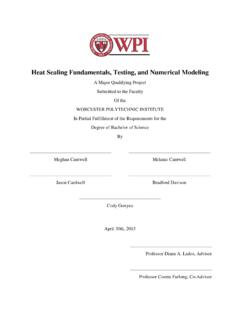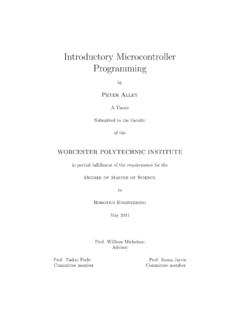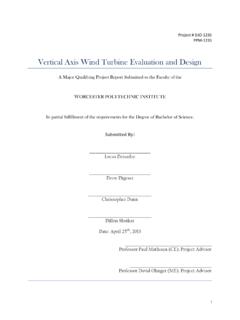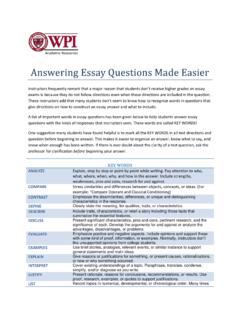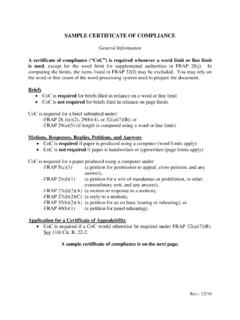Transcription of PWM Techniques: A Pure Sine Wave Inverter
1 2010-2011 Worcester Polytechnic Institute Major Qualifying Project pwm techniques : A. pure sine Wave Inverter Advisor: Professor Stephen J. Bitar, ECE. Student Authors: Ian F. Crowley Ho Fong Leung 4/27/2011. Contents Figures .. 3. Abstract .. 6. Introduction .. 7. Problem Statement .. 8. Background 10. Prior 10. Comparison of Commercially Available Inverters .. 11. Examination of an Existing Design .. 15. DC to AC Inversion .. 16. Square Wave 16. Modified sine Wave Inverters .. 18. pure sine Wave 19. PWM .. 20. 2-Level PWM .. 20. 3-Level PWM .. 22. Examining 3-Level PWM in 25. 5-Level PWM .. 27. IGBTs vs. Power MOSFETs .. 31. Amplitude 32. H-Bridge Components and Power Losses .. 36.
2 IRFP460A 36. IR2304 MOSFET Driver IC .. 36. Power Loss and 38. Typical PWM .. 38. Our 39. Filter Components .. 41. Control Signal Generation for 2-Level PWM .. 42. A Stable Operation 42. Triangle Wave 45. sine Wave Generator .. 46. 2. PWM Signal from Comparators .. 51. Signal Generation for 3-Level PWM .. 54. Features of the TL494 .. 54. Programmable Switching Frequency .. 54. Two Error Amplifiers .. 54. Minimum Dead Time (Maximum Duty Cycle) .. 54. Using the 55. Results .. 63. Low-Voltage Test .. 64. High Voltage Testing .. 66. 200W Resistive Load .. 66. Inductive Load Test .. 70. Printed Circuit 71. Power Efficiency .. 75. Conclusion and Recommendations .. 77. References .. 79.
3 Appendix A: Circuit Schematic .. 80. Appendix B: Parts List .. 91. Figures Figure 1:Square, Modified sine , and sine waves Comparison .. 11. Figure 2: A Modified sine Wave Inverter .. 16. Figure 3: Square Wave .. 17. Figure 4: Square Wave Harmonic Analysis .. 17. Figure 5: Modified sine Wave .. 18. Figure 6: Modified sine Wave Harmonic Analysis .. 19. Figure 7: 2-Level PWM Comparison 20. Figure 8: 2-Level PWM Output (Unfiltered).. 21. Figure 9: 2-Level PWM Harmonic Analysis .. 21. Figure 10: 2-Level PWM Output (Filtered) .. 22. Figure 11: 3-Level PWM Comparison Control 23. Figure 12: 3-Level PWM Simulation Circuit .. 23. Figure 13: Simulated 3-Level PWM Output (Unfiltered) .. 24. 3.
4 Figure 14: Simulated 3-Level PWM Output (Filtered) .. 24. Figure 15: 3-Level PWM Harmonics Analysis of Unfiltered Output .. 25. Figure 16: Block Diagram from "DC/AC pure sine Wave Inverter " 26. Figure 17:5-Level PWM Simulation Circuit .. 28. Figure 18: 5-Level PWM Comparison 29. Figure 19: PWM Bridge Control Signals (superimposed) .. 29. Figure 20: 5-Level PWM Output (unfiltered) .. 30. Figure 21: 5-Level PWM Output (filtered) .. 30. Figure 22: 5-Level PWM Harmonics Analysis of Unfiltered Output .. 31. Figure 23: Filtered Outputs ma to .. 34. Figure 24: Bipolar PWM Test Circuit .. 35. Figure 25: IR2304 .. 37. Figure 26: Voltage vs. State of Charge of a Sealed Lead Acid Battery.
5 43. Figure 27: Dropout Voltage of the LM317 .. 44. Figure 28: Voltage Regulation Circuit .. 44. Figure 29: Triangle Wave Generator Circuit .. 45. Figure 30: Output of the Triangle Wave Generator .. 46. Figure 31: Schmitt Trigger 47. Figure 32: Butterworth Low-Pass Filter .. 48. Figure 33: Square and sine waves from the Above 49. Figure 34: Revised sine Wave Generator .. 50. Figure 35: sine Wave from the Revised 50. Figure 36: Comparison of Positive and Negative Swings of the 60 Hz sine 51. Figure 37: MC3302 Equivalent Circuit .. 52. Figure 38: Comparator 52. Figure 39 PWM Signals for Both Halves of the H-Bridge .. 53. Figure 40: TL494 Dead Time 55. Figure 41: TL494 Inputs .. 55. Figure 42: Precision Rectifiers for Half-Wave Generation.
6 57. Figure 43: Half-Wave Rectifier Outputs .. 58. Figure 44: Inverting Gain Stage for the Half waves .. 58. Figure 45: Outputs of the Inverting Amplfiers .. 59. Figure 46: TL494 Configuration .. 60. Figure 47: Sampling the Input with a Saw-Tooth Wave .. 60. Figure 48: Grounding the Bootstrap Capacitor .. 61. Figure 49: PWM Signal from the TL494 (Top) and its Inversion (Bottom) .. 62. Figure 50: Alternating PWM Signals for Both High Side Gate Half-Cycles .. 62. Figure 51: Final Inverter Design .. 63. Figure 52: Low-Voltage Test Half-Bridge Vgs Waveforms .. 64. Figure 53:Filtered Low-Voltage Output across 12 VDC Headlight .. 65. Figure 54: Low-Voltage Output Cross-Over Distortion.
7 66. Figure 55: High Voltage Half-Bridge Vgs 67. 4. Figure 56: High-Voltage Filtered Output Waveform (showing Breakdown Distortion) .. 68. Figure 57: Unfiltered High-Voltage Output with a 200W 68. Figure 58: Unfiltered Output FFT w/200W Resistive Load .. 69. Figure 59: Output FFT showing 60Hz peak .. 70. Figure 60: Unfiltered Output with Inductive Load .. 71. Figure 61: sine Wave Inverter PCB .. 73. Figure 62: Populated 73. Figure 63: PCB gate voltage waveforms (one half-bridge) .. 74. Figure 64: PCB filtered output waveform .. 74. 5. Abstract The ever-increasing reliance on electronic devices which utilize AC power highlights the problems associated with the unexpected loss of power from the electrical grid.
8 In places where the electrical infrastructure is not well-developed, brown-outs can prove fatal when electronic medical instruments become unusable. Therefore, there is a need for inexpensive and reliable pure - sine wave inverters for use with medical devices in the underdeveloped world. This report documents the development of one component of an uninterruptible power supply, the DC-to-AC Inverter . Through the use of analog signal processing techniques, a prototype which efficiently and accurately emulates the pure - sine wave power present on the power grid was created. The three-level PWM system within this report is created with the possibility of a feedback-regulated system to be implemented in the future.
9 6. Introduction Conventionally, there are two ways in which electrical power is transmitted. Direct current (DC). comes from a source of constant voltage and is suited to short-range or device level transmission. Alternating current (AC) power consists of a sinusoidal voltage source in which a continuously changing voltage (and current) can be used to employ magnetic components. Long distance electrical transmission favors AC power, since the voltage can be boosted easily with the use of transformers. By boosting the voltage, less current is needed to deliver a given amount of power to a load, reducing the resistive loss through conductors. The adoption of AC power has created a trend where most devices adapt AC power from an outlet into DC power for use by the device.
10 However, AC power is not always available and the need for mobility and simplicity has given batteries an advantage in portable power. Thus, for portable AC power, inverters are needed. Inverters take a DC voltage from a battery or a solar panel as input, and convert it into an AC voltage output. There are three types of DC/AC inverters available on the market, which are classified by their output type: square wave, modified- sine wave and pure sine wave. Off-the-shelf inverters are generally either square wave or modified- sine wave. These types of inverters are less expensive to make and the output, though delivering the same average voltage to a load, is not appropriate to delicate electronic devices which rely on precise timing.
